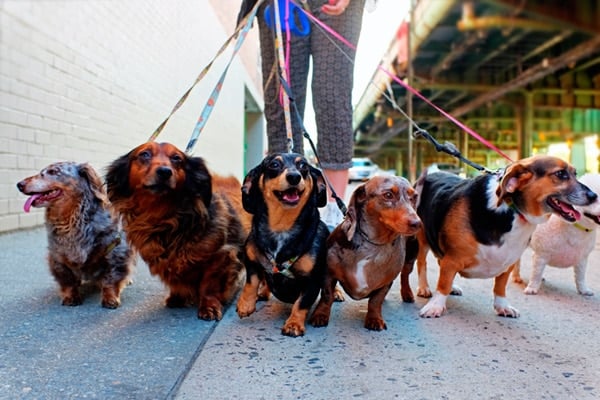Teaching your dog to walk is very simple if you know how to do it. You’ve definitely seen dozens of dogs walking with their owners on the street; many of them walk properly, but others walk very, very badly. Walking a dog who can’t walk properly can be a real nuisance; jerking, overtaking, pulling on the leash and endless problems that can turn a nice walk into an ordeal.
Whether your dog is an adult or a puppy, you should teach him to walk with you. Dogs don’t know if they are doing it right or wrong; they just walk and their owners are the ones who must indicate if it’s right or wrong, and correct or praise them. Most behavior problems in dogs’ walking are due to poor communication between owner and dog, not a bad dog.

If your dog is a puppy, you should have him vaccinated before going outside with him, and get him used to wearing his collar all the time. When he’s a bit older and used to it, you can remove it at home or whenever you want, but as long as he’s a puppy, it’s recommended that he wears it at all times, gets used to it and learns not to see it as a problem on his neck. Remember that puppies grow quickly, so you should check that the collar isn’t too tight (you should be able to put a couple of fingers between the strap and your puppy’s neck with no problem).
Now we’ll learn to train our dog or puppy to go for a walk with us, without jerking or jolting. Taking a peaceful walk with your dog is something really simple that only requires a little practice and patience. Forget all the techniques you’ve learned before and start implementing these; you’ll see that you’ll get good results very soon.

Step 1: Tiring them out
When a puppy or adult dog goes outside, the first thing they want to do is run, play, pee, greet other dogs, etc. This is something completely normal, and it’s why they are so energetic when they leave home, full of vitality and with a great desire to play.
The first thing to do before we teach our dog any task such as walking, lying down, fetching objects, etc. is to let him tire himself out. By eliminating that extra energy, you’ll have a much more submissive and trainable dog, so the first thing to do is let him let it all out.
It’s a good idea to take him to a dog park or place where he can run free, play, sniff – in short, a place where he can let off steam and get tired. Don’t rush the process. Don’t throw a stick 200 times to get him exhausted; you have to let him do it naturally, so you should allot half an hour to an hour for them to just enjoy themselves.
Once the dog has done what he needs to do – played, sniffed around and gotten tired – you can begin to train him, keeping in mind that to have an energetic and happy dog you must feed him a high quality natural dog food.
Step 2: Choose an appropriate place for training
To teach your dog to walk, you should choose a quiet place where he won’t be easily distracted and where he won’t receive many stimuli (when he has learned the basics, you can practice in more stimulating environments). A good place to walk can be a park that isn’t used much, a country road, etc. If your dog is learning in a place where he sees other dogs playing, kids screaming, balls bouncing, etc., he won’t learn anything because he’ll be paying more attention to these stimuli than to his owner.

Step 3: Preparing the dog… and the owner
To start teaching your dog or puppy to walk, you need to be completely relaxed. We humans indirectly convey our problems to our dogs, so if an owner is tense or stressed, the dog will notice that tension and won’t be calm. To train your dog to walk, you must be calm and be in a good mood, unhurried and eager to teach.
Your dog or puppy should already be used to wearing his collar, so the only thing left is to put on the leash. It’s very important to use a short leash to teach your dog to walk, and retractable leashes won’t do. A leash of three feet, more or less, is a good leash to teach your puppy or adult dog to walk beside you.
Once your dog is tired and you have gone to a quiet area where he can start learning, all that’s left is to put on the leash and start the lesson.
Step 4: Starting to walk
Have your dog or puppy sit, put on the leash, stand beside him and start walking. Use a moderate pace, not too slow or too fast. It’s very important that the leash isn’t tense; there should be some slack hanging in the middle so as not to transmit any tension.
If your dog or puppy rushes forward, the instant you notice tension on the leash, stop short. When he turns around and approaches you (and the leash is no longer taut), start walking again. This should be repeated every day so that he gets the message that when he pulls, he can’t keep going.
If he constantly rushes forward and jerks, instead of stopping short and waiting until the leash is slack again, you can make a 180 degree turn and walk in the opposite direction, repeating the same step as many times as necessary until the dog pays attention to you and when you turn, he turns too, at the same time with you.
Another option, if the first two are impossible because he pulls very hard and doesn’t respond, is to keep a dog treat in your hand (a small piece of kibble, piece of sausage, etc.), making him walk with you. When he does, reward him and put a new treat in your hand, and two or three yards later reward him again. Walking nonstop, repeat the process and reward him after five or six yards. The trick is to progressively lengthen the time it takes to receive his reward, so that he walks beside you (not in front or pulling) and gets his reward.
Walk straight and try varying the pace: for a few minutes, walk quickly (without letting him go in front of you, stop short if this happens and the leash gets tense) and then switch to a slower pace, where he also must walk alongside you, not in front.
If your dog or puppy gets left behind, just walk a little slower and keep a small reward in your hand so that he positions himself next to you. When he’s at your side, the leash should be slack; remember that there shouldn’t be any tension as a general rule.

Step 5: Teach your dog or puppy to walk
Training your dog or puppy to walk properly is not achieved in a day, a week or even a month. We can see constant progress, but we need to be patient and repeat the steps daily for a considerable time.
There are dogs that learn to walk properly in a month and others that takes six months; the important thing is not the time, but enjoying it. Training your dog isn’t sacrificing your time, but sharing it with him and investing in his future (and your own comfort in the future).
By repeating the steps indicated in step four on a regular basis, you will see great progress little by little. When your dog knows how to walk fairly well, you can take him on walks with friends who also have dogs, so your dog sees that other dogs also walk with their owners and don’t feel the need to play. Remember that getting him exhausted before training is a fundamental step.

Practical tips
- Do the steps as described: let your dog tire himself out and then begin the lesson. Never begin a lesson with an energetic dog, it’s useless.
- Avoid making him learn under the hot sun; try to make sure it’s not too hot or your dog will just want to look for shade.
- Forget about choke/punishment collars, anti-pull leashes, etc. All dogs can learn with a regular collar and medium sized leash.
- Your mood is essential. If you’re not calm and with a positive attitude, don’t give the lesson.
- If your dog is too upset, sit him down, lie him down and massage him. Make him relax naturally and then start the lesson.
- Never let a young child give lessons for you; only the owner or an experienced adult (trainer) can give lessons.
- Have tons of patience. Some dogs take several months to learn to walk properly; everything is a matter of practice and patience. There’s no magic trick.
- If the situation is more than you can handle, or if you don’t have time, go to a professional, but you should always, always be present during training.
If you liked this article and found it useful, help us keep the site going! “Like” or share it on social media: Thank you! 🙂





